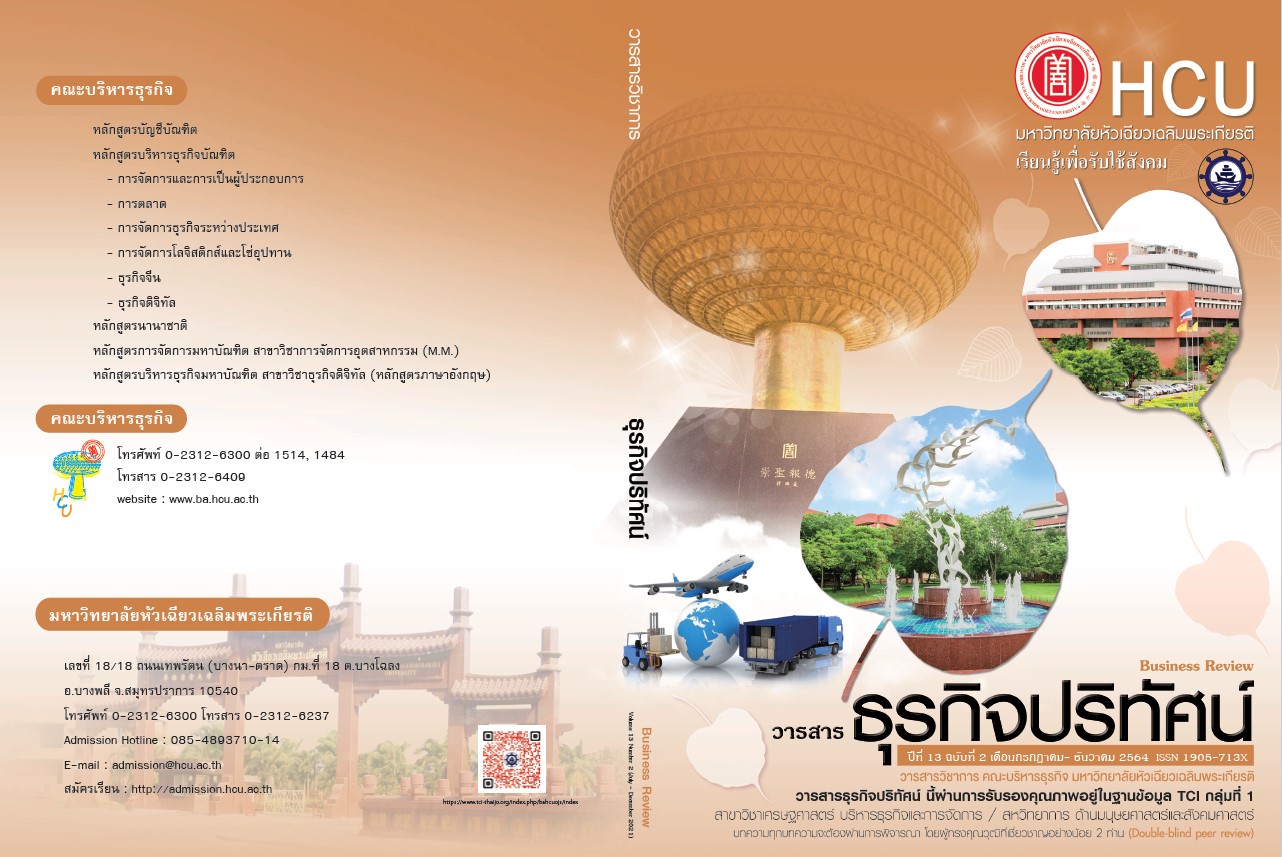โมเดลสมการโครงสร้างของปัจจัยที่มีอิทธิพลต่อความได้เปรียบทางการแข่งขันของผู้ผลิตชิ้นส่วนยานยนต์ในเขตพัฒนาพิเศษภาคตะวันออก
关键词:
ความได้เปรียบทางการแข่งขัน, ผู้ผลิตชิ้นส่วนยานยนต์, เขตพัฒนาพิเศษภาคตะวันออก(EEC)摘要
การศึกษาเชิงปริมาณนี้มีวัตถุประสงค์เพื่อศึกษาปัจจัยที่มีอิทธิพลต่อความได้เปรียบทางการแข่งขันของผู้ผลิตชิ้นส่วนยานยนต์ในเขตพัฒนาพิเศษภาคตะวันออกของประเทศไทย และเพื่อตรวจสอบความกลมกลืนของโมเดลสมการโครงสร้างความได้เปรียบทางการแข่งขันของอุตสาหกรรมการผลิตชิ้นส่วนยานยนต์ในเขตพัฒนาพิเศษภาคตะวันออกที่พัฒนาขึ้นกับข้อมูลเชิงประจักษ์ โมเดลสมการโครงสร้างที่ใช้ในการศึกษานี้ได้ถูกสร้างขึ้นจากการทบทวนวรรณกรรมและงานวิจัยที่เกี่ยวข้องซึ่งประกอบด้วยตัวแปรที่สำคัญจำนวน 4 ตัวแปร คือ ความได้เปรียบทางการแข่งขัน นวัตกรรม ภาวะผู้นำการเปลี่ยนแปลง และองค์การแห่งเรียนรู้ กลุ่มประชากรจำนวน 280 คน ซึ่งกำหนดให้เป็นระดับผู้จัดการในโรงงานอุตสาหกรรมชิ้นส่วนยานยนต์ในเขตพัฒนาพิเศษภาคตะวันออก (EEC) และทดสอบด้วยสถิติโมเดลสมการโครงสร้างของความได้เปรียบทางการแข่งขันของผู้ผลิตชิ้นส่วนยานยนต์ในเขตพัฒนาพิเศษภาคตะวันออก (EEC) มีความกลมกลืนและเป็นไปตามทฤษฎีโดยมีตัวชี้วัดคือ Chi-square (χ2) = 70.110, df = 55, p-value = .082, CMIN/DF (χ2⁄df) = 1.275, GFI = .966, AGFI = .934, CFI = .992, NFI = .967 and RMSEA = .031
参考
การนิคมอุตสาหกรรมแห่งประเทศไทย. (2562). รายชื่อโรงงาน. สืบค้นเมื่อ 26 สิงหาคม 2562, จากการนิคมอุตสาหกรรมแห่งประเทศไทย (กนอ.)เว็บไซต์: https://www.ieat.go.th/ieat-industry-port-factory/ieat-factory-list.
กองเศรษฐกิจ สำนักงานปลัดกระทรวง กระทรวงแรงงาน. (2560). รายงานการศึกษาวิเคราะห์ฐานข้อมูลแรงงานและประมาณการความต้องการแรงงานของอุตสาหกรรมเป้าหมายในพื้นที่ระเบียงเศรษฐกิจภาคตะวันออก (EEC). สืบค้นเมื่อ 26 สิงหาคม 2562, จากศูนย์ข้อมูลแรงงานแห่งชาติเว็บไซต์:http://nlic.mol.go.th/sites/default/files/Documents/EEC.pdf.
เจษฎา นกน้อย. (2552). นานาทรรศนะการจัดการความรู้และการสร้างองค์การแห่งการเรียนรู้. กรุงเทพฯ: บริษัท ส.เอเซียเพรส(1989) จำกัด.
นงลักษณ์ วิรัชชัย. (2548). แนวโน้มการวิจัยในยุคสังคมความรู้. วารสารบริหารการศึกษา มหาวิทยาลัยขอนแก่น, 1(2), 9-18.
บุษยา วีระกุล. (2558). ภาวะผู้นำ. กรุงเทพฯ: สำนักงานกิจการโรงพิมพ์ องค์การสงเคราะห์ทหารผ่านศึก.
ศิวะนันท์ ศิวพิทักษ์. (2554). การจัดการนวัตกรรมขององค์กรธุรกิจที่มีผลต่อพฤติกรรมการสร้างสรรค์นวัตกรรมของพนักงาน. ดุษฎีนิพนธ์ปริญญาดุษฎีบัณฑิต, มหาวิทยาลัยธุรกิจบัณฑิตย์.
ศูนย์วิจัยกรุงศรี. (2560). แนวโน้มธุรกิจ/อุตสาหกรรม ปี 2560-62 อุตสาหกรรมรถยนต์. สืบค้นเมื่อ 29 พฤษภาคม 2562, จากศูนย์วิจัยกรุงศรี เว็บไซต์: https://www.krungsri.com/bank/getmedia/cf250dec-3bbe-4629-8a6b40f7937eee4b/IO_Automobile_2017_TH.aspx.
ศูนย์วิจัยกสิกรไทย. (2560). SME ไทยก้าวทันกระแสยานยนต์ยุค 4.0 แล้วหรือยัง. สืบค้นเมื่อ 29 พฤษภาคม 2562, จากศูนย์วิจัยกรุงศรี เว็บไซต์: https://www.kasikornbank.com/th/business/sme/KSMEKnowledge/article/KSMEAnalysis/Pages/Thai-Automotive_4-0.aspx.
สัมฤทธิ์ จำนง. (2557). ภาพลักษณ์องค์กรและนวัตกรรมที่ส่งผลต่อความภักดีของผู้ใช้บริการไปรษณีย์ด่วนพิเศษในประเทศในเขตกรุงเทพมหานคร. บริหารธุรกิจมหาบัณฑิต, มหาวิทยาลัยกรุงเทพ.
อำนาจ ธีระวนิช. (2553). การจัดการยุคใหม่. พิมพ์ครั้งที่ 3. กรุงเทพมหานคร: มาเธอร์ บอส แพคเกจจิ้ง.
Barney, J.B. (1991). Firm Resources and Sustained Competitive Advantage. Journal of Management, 17, 99–120.
Best, J. W., & Kahn, J. V. (1998). Research in education. 8th ed. Boston: Allyn and Bacon.
Beyene, K. T., Shi, C. S., & Wu, W. W. (2016). The impact of Innovation Strategy on Organization Learning and Innovation Performance: Do firm size and Ownership type make a difference. South African Journal of Industrial Engineering, 27(1), 125-136.
Burns, J.M. (1978). Leadership. New York: Harper & Row.
Hair, J. F., Sarstedt, M., Ringle, C. M., & Mena, J. A. (2012). An assessment of the use of partial least squares structural equation modeling in marketing research. Journal of the academy of marketing science, 40(3), 414-433.
Ilker, M. A. (2012). The impact of green product innovation on firm performance and competitive capability: the moderating role of managerial environmental concern. Social and Behavioral Sciences, 62, 854–864.
Joseph, F., Hair, J., William, C. B., Barry, J. B., & Rolph, E. A. (2014). Multivariate Data Analysis (7thed.). New Jersey: Pearson Education Limited.
Jung, D., Wu, A., & Chow, C. (2008). Towards understanding the direct and indirect effects of CEOs' transformational leadership on firm innovation. The Leadership Quarterly, 19, 582–594.
Masood, N. K., & Nosheen, R. (2013). Organizational learning culture’: an ingenious device for promoting firm’s innovativeness. The Service Industries Journal, 33(12), 1135–1147.
Mavis, Y. C. C., Carol, Y. Y. L., Hsing-Er, L., & Edward, F. M. III. (2012). Does transformational leadership facilitate technological innovation the moderating roles of innovative culture and incentive compensation. Asia Pac J Manag, 29, 239 – 264.
Mirva, H., & Satu, P. (2013). Boosting Creativity with Transformational Leadership in Fuzzy Front-end Innovation Processes. Interdisciplinary Journal of Information, Knowledge, and Management, 8, 21-41.
Murat, A., Nilgun, A., & Fulya, S. (2013). The relationship between innovation and firm performance: An empirical evidence from Turkish automotive supplier industry. Social and Behavioral Sciences, 75, 226–235.
Oh, J., & Rhee, S. K. (2010). Influences of supplier capabilities and collaboration in new car development on competitive advantage of carmakers, Management Decision, 48(5), 756–774.
Rabia, K., Abaid, U. R., & Afsheen, F. (2009). Transformational leadership and organizational innovation: Moderated by organizational size. African Journal of Business Management, 3(11), 678-684.
Rebecca, W., & Paul, A. G. J. (2006). A Brief Guide to Structural Equation Modelling. THE COUNSELING PSYCHOLOGIST, 34(5), 719-751.
Sanchez de Pablo Gonzalez del Campo, J. D., & Miha, S. (2011). The organizational learning process as facilitator of innovativeness. Innovation and Learning, 9(4), 401-421.
Senge, P.M. (1991). Team Learning. Mckinsey Quarterly, 1, 82-93.
Shahzad, K., & Muhammad, A. A. (2013). Role of Leadership Style and Its Impact on Getting Competitive Advantage. European Journal of Applied Sciences, 5(2), 53-61.
Sri, M. S., Monica, R., & Mohd, N. M. S. (2017). Competitive Advantage as Mediating Variable on the Relationship between Innovation and Business Performance on SMES in Purwokerto Province. Saudi Journal of Business and Management Studies, 2(7), 693–699.
Stata, R. (1989). Organizational Learning-The key to Management Innovation. Sloan Management Review, 30(3), 63-74.
Susana, P. L., Jose, M. M. P., & Camilo, J. V. O. (2005). Organizational learning as a determining factor in business performance, The Learning Organization, 12, 227–245.
Víctor, J. C. M., María, M. J. B., & Leopoldo, G. G. (2012). Transformational leadership influence on organizational performance through organizational learning and innovation. Journal of Business Research, 65, 1040–1050.
Wang, W. C., Lin, C. H., & Chu, Y. C. (2011). Type of Competitive Advantage and Analysis. International Journal of Business and Management, 6(5), 100 – 104.
Wawmayura, C., Wanno, F., & Josu, T. (2017). The effects of R&D and Innovation Capabilities on the Thai automotive industry part’s Competitive Advantage: A SEM approach, Management and Production Engineering Review, 8(1), 101 – 112.
Wolfe, R. A. (1994). Organizational Innovation: Review, Critique and Suggested Research Directions. Journal of Management Studies, 31(3), 405-431.
Yang, C., Guiyao, T., Jiafei, J., Qinghong, X., & Ji, L. 2014. CEOs’ Transformational Leadership and Product Innovation Performance: The Roles of Corporate Entrepreneurship and Technology Orientation. Journal of Product Innovation Management, 31(1), 2–17.
##submission.downloads##
已出版
##submission.howToCite##
期
栏目
##submission.license##
บทความที่ได้รับการตีพิมพ์เป็นลิขสิทธิ์ของวารสารธุรกิจปริทัศน์
ข้อความที่ปรากฏในบทความแต่ละเรื่องในวารสารวิชาการเล่มนี้เป็นความคิดเห็นส่วนตัวของผู้เขียนแต่ละท่านไม่เกี่ยวข้องกับมหาวิทยาลัยหัวเฉียวเฉลิมพระเกียรติ และคณาจารย์ท่านอื่น ๆ ในมหาวิทยาลัยฯ แต่อย่างใด ความรับผิดชอบองค์ประกอบทั้งหมดของบทความแต่ละเรื่องเป็นของผู้เขียนแต่ละท่าน หากมีความผิดพลาดใดๆ ผู้เขียนแต่ละท่านจะรับผิดชอบบทความของตนเองแต่ผู้เดียว




